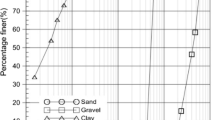Abstract
Numerous studies have been performed on the behavior of stone columns subjected to vertical loads. However, little research has been focused on determining the shear strength and equivalent shear strength parameters of cohesive soils reinforced with stone columns. The performed research in this area mostly includes numerical analyses which do not consider the effect of stress concentration ratio, and the value of stress concentration ratio in such analyses is assumed to be 1. In this study, an experimental investigation has been carried out on stone columns subjected to vertical and shear loads, with the purpose of determining the actual value of stress concentration ratio. The experiments were performed in a large direct shear device. In this study, single, square and triangular arrangements of stone columns with three different area replacement ratios under three vertical loads were investigated. Soft clay was used as bed material, and stone column material was either crushed stone or fine-grained sand. Results showed that stress concentration ratio decreased with the increase in stone column diameter and vertical stress and the value of stress concentration ratio is highest for square arrangement and lowest for single stone columns. The equivalent shear parameters obtained from experiments and those predicted by analytical relationships were compared at stress concentration value of 1 and stress concentration values obtained from the experiments. Results also showed that the shear strength value and the equivalent shear strength parameters measured from experiments were higher than those predicted by analytical relationships.























Similar content being viewed by others
References
Abusharar SW, Han J (2011) Two-dimensional deep-seated slope stability analysis of embankments over stone column-improved soft clay. Eng Geol 120(1–4):103–110
Alamgir M, Miura N, Poorooshasb HB, Madhav MR (1996) Deformation analysis of soft ground columnar inclusions. Comput Geotech 18(4):261–290
Ambily A, Gandhi SR (2006) Effect of sand pad thickness on load sharing in stone column. In: Proceedings Indian geotechnical conference, Chennai
Barksdale RD, Bachus RC (1983) Design and construction of stone column, vol 1. FHWA/RD
Castro J (2017) Groups of encased stone columns: influence of column length and arrangement. Geotext Geomembr 45(2):68–80
Chen JF, Li LY, Xue JF, Feng SZ (2015) Failure mechanism of geosynthetic-encased stone columns in soft soils underembankment. Geotext Geomembr 43(5):424–431
Christoulas ST, Giannaros CH, Tsiambaos G (1997) Stabilization of embankment foundations by using stone columns. Geotech Geol Eng 15(3):247–258
Cooper M, Rose AN (1999) Stone column support for an embankment on deep alluvial soils. ICE Proc Geotech Eng 137(1):15–25
Deb K, Samadhiya NK, Namdeo JB (2011) Laboratory model studies on unreinforced and geogrid-reinforced sand bed over stone column-improved soft clay. Geotext Geomembr 29(2):190–196
Fattah MY, Shlash KT, Al-Waily MJ (2010) Stress concentration ratio of model stone columns in soft clays. Geotech Test J 34(1):50–60
Fox Z (2011) Critical state, “dilatancy and particle breakage of mine waste rock; Colorado State University”. Degree of Master of Science: Fort Collins, USA
Ghazavi M, Nazariafshar J (2013) Bearing capacity of geosynthetic encased stone columns. Geotext Geomembr J 28:26–36
Gniel J, Bouazza A (2008) Improvement of soft soils using geogrid encased stone columns. Geotext Geomembr 27(3):167–175
Goughnour RR, Bayuk AA (1979) A field study of long term settlements of loads supported by stone columns in soft ground. In: Proceeding, international conference on soil reinforcement
Han J, Ye SL (2001) Simplified method of consolidation rate of stone column reinforced foundation. J Geotech Geoenviron Eng 127(7):597–603
Hosseinpour I, Riccio M, Almeida MSS (2014) Numerical evolution of a granular column reinforced by geosynthetics using encasement and laminated disks. Geotext Geomembr 42:363–373
Mehrannia N, Kalantary F, Ganjian N (2018) Experimental study on soil improvement with stone columns and granular blankets. J Cent South Univ 25(4):878
Mestar P, Riou Y (2004) Validation des modeles numeriques de sol ameliore par colonnes. In: Proceedings international symposium on ground improvement, pp 229–243
Mohapatra SR, Rajagopal K, Sharma J (2016) Direct shear tests on geosynthetic-encased granular columns. Geotext Geomembr 44(3):396–405
Murugesan S, Rajagopal K (2008) Shear load tests on granular columns with and without geosynthetic encasement. Geotech Test J 32(1):35–44
Murugesan S, Rajagopal K (2010) Studies on the behavior of single and group of geosynthetic encased stone columns. Geotech Geoenviron Eng 136:129–139
Najjar S, Sadek S, Maakaroun T (2010) Effect of sand columns on the undrained load response of soft clay. J Geotech Geoenviron Eng ASCE 136(9):1263–1277
Nayak NV (1983) Recent advances in ground improvements by stone column. In: Proceedings of Indian geotechnical conference, Madras, India
Nazariafshar J, Ghazavi M (2014) A simple analytical method for calculation of bearing capacity of stone column. Int J Civ Eng 12(1):1–15
Nazariafshar J, Mehrannia N, Kalantary F (2017) Experimental investigation on the bearing capacity of stone columns with granular blankets. Geotech Geol Eng 36(1):209–222
Nazariafshar J, Mehrannia N, Kalantary F, Ganjian N (2019) Bearing capacity of group of stone columns with granular blankets. Int J Civ Eng 17(2):253–263
Ng KS (2014) Numerical study and design criteria of floating stone columns. National University of Singapore, Singapore
Priebe H (1978) Abschatzung des Scherwiderstandes eines durgh Stopfverdichtung verbesserten Baugrundes. Die Bautechnik 55(9):281–284
Stoeber JN (2012) Effects of maximum particle size and sample scaling on the mechanical behavior of mine waste rock: a critical state approach. M.Sc. dissertation, Colorado State University, Fort Collins, USA
Vekli M, Aytekin M, İkizler B, Calik U (2012) Experimental and numerical investigation of slope stabilization by stone columns. Nat Hazards 64(1):797–820
Zhang L, Zhao M, Shi C, Zhao H (2013) Settlement calculation of composite foundation reinforced with stone columns. Int J Geomech 13(3):248–256
Author information
Authors and Affiliations
Corresponding author
Rights and permissions
About this article
Cite this article
Nazariafshar, J., Aslani, M. Effect of Stress Concentration Ratio on Shear Strength of Soft Soils Improved with Stone Columns. Iran J Sci Technol Trans Civ Eng 45, 315–334 (2021). https://doi.org/10.1007/s40996-020-00391-z
Received:
Accepted:
Published:
Issue Date:
DOI: https://doi.org/10.1007/s40996-020-00391-z




